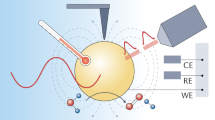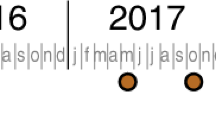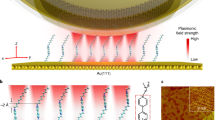Abstract
Plasmonic resonances can concentrate light into exceptionally small volumes, which approach the molecular scale. The extreme light confinement provides an advantageous pathway to probe molecules at the surface of plasmonic nanostructures with highly sensitive spectroscopies, such as surface-enhanced Raman scattering. Unavoidable energy losses associated with metals, which are usually seen as a nuisance, carry invaluable information on energy transfer to the adsorbed molecules through the resonance linewidth. We measured a thousand single nanocavities with sharp gap plasmon resonances spanning the red to near-infrared spectral range and used changes in their linewidth, peak energy and surface-enhanced Raman scattering spectra to monitor energy transfer and plasmon-driven chemical reactions at their surface. Using methylene blue as a model system, we measured shifts in the absorption spectrum of molecules following surface adsorption and revealed a rich plasmon-driven reactivity landscape that consists of distinct reaction pathways that occur in separate resonance energy windows.
This is a preview of subscription content, access via your institution
Access options
Access Nature and 54 other Nature Portfolio journals
Get Nature+, our best-value online-access subscription
$29.99 / 30 days
cancel any time
Subscribe to this journal
Receive 12 print issues and online access
$259.00 per year
only $21.58 per issue
Buy this article
- Purchase on Springer Link
- Instant access to full article PDF
Prices may be subject to local taxes which are calculated during checkout




Similar content being viewed by others
Data availability
Datasets generated during and/or analysed during the current study are available online at https://doi.org/10.6084/m9.figshare.15051894.v1.
Code availability
All custom codes used in the current study are provided along with the relevant data online at https://doi.org/10.6084/m9.figshare.15051894.v1.
References
Wang, F. & Shen, Y. R. General properties of local plasmons in metal nanostructures. Phys. Rev. Lett. 97, 206806 (2006).
Baumberg, J. J., Aizpurua, J., Mikkelsen, M. H. & Smith, D. R. Extreme nanophotonics from ultrathin metallic gaps. Nat. Mater. 18, 668–678 (2019).
Liang, Z., Sun, J., Jiang, Y., Jiang, L. & Chen, X. Plasmonic enhanced optoelectronic devices. Plasmonics 9, 859–866 (2014).
Atwater, H. A. & Polman, A. Plasmonics for improved photovoltaic devices. Nat. Mater. 9, 205–213 (2010).
Zhang, Y. et al. Surface-plasmon-driven hot electron photochemistry. Chem. Rev. 118, 2927–2954 (2018).
Brongersma, M. L., Halas, N. J. & Nordlander, P. Plasmon-induced hot carrier science and technology. Nat. Nanotechnol. 10, 25–34 (2015).
Haes, A. J., Zou, S., Zhao, J., Schatz, G. C. & Van Duyne, R. P. Localized surface plasmon resonance spectroscopy near molecular resonances. J. Am. Chem. Soc. 128, 10905–10914 (2006).
Kumar, P. V. et al. Plasmon-induced direct hot-carrier transfer at metal–acceptor interfaces. ACS Nano 13, 3188–3195 (2019).
Taylor, A. B. & Zijlstra, P. Single-molecule plasmon sensing: current status and future prospects. ACS Sens. 2, 1103–1122 (2017).
Zhan, C., Moskovits, M. & Tian, Z.-Q. Recent progress and prospects in plasmon-mediated chemical reaction. Matter 3, 42–56 (2020).
Darby, B. L., Auguié, B., Meyer, M., Pantoja, A. E. & Le Ru, E. C. Modified optical absorption of molecules on metallic nanoparticles at sub-monolayer coverage. Nat. Photon. 10, 40–45 (2016).
Dubi, Y., Un, I. W. & Sivan, Y. Thermal effects—an alternative mechanism for plasmon-assisted photocatalysis. Chem. Sci. 11, 5017–5027 (2020).
Yu, S. & Jain, P. K. The chemical potential of plasmonic excitations. Angew. Chem. Int. Ed. 59, 2085–2088 (2020).
Seemala, B. et al. Plasmon-mediated catalytic O2 dissociation on Ag nanostructures: hot electrons or near fields? ACS Energy Lett. 4, 1803–1809 (2019).
Tesema, T. E., Kafle, B. & Habteyes, T. G. Plasmon-driven reaction mechanisms: hot electron transfer versus plasmon-pumped adsorbate excitation. J. Phys. Chem. C 123, 8469–8483 (2019).
Kamarudheen, R., Aalbers, G/ J. W., Hamans, R. F., Kamp, L. P. J. & Baldi, A. Distinguishing among all possible activation mechanisms of a plasmon-driven chemical reaction. ACS Energy Lett. 5, 2605–2613 (2020).
Baffou, G., Bordacchini, I., Baldi, A. & Quidant, R. Simple experimental procedures to distinguish photothermal from hot-carrier processes in plasmonics. Light Sci. Appl. 9, 108 (2020).
Kazuma, E., Jung, J., Ueba, H., Trenary, M. & Kim, Y. Real-space and real-time observation of a plasmon-induced chemical reaction of a single molecule. Science 360, 521–526 (2018).
Brandt, N. C., Keller, E. L. & Frontiera, R. R. Ultrafast surface-enhanced Raman probing of the role of hot electrons in plasmon-driven chemistry. J. Phys. Chem. Lett. 7, 3179–3185 (2016).
Boerigter, C., Campana, R., Morabito, M. & Linic, S. Evidence and implications of direct charge excitation as the dominant mechanism in plasmon-mediated photocatalysis. Nat. Commun. 7, 10545 (2016).
Tan, S. et al. Plasmonic coupling at a metal/semiconductor interface. Nat. Photon. 11, 806–812 (2017).
Hervier, A., Renzas, J. R., Park, J. Y. & Somorjai, G. A. Hydrogen oxidation-driven hot electron flow detected by catalytic nanodiodes. Nano Lett. 9, 3930–3933 (2009).
Zheng, Z., Tachikawa, T. & Majima, T. Plasmon-enhanced formic acid dehydrogenation using anisotropic Pd–Au nanorods studied at the single-particle level. J. Am. Chem. Soc. 137, 948–957 (2015).
Jain, P. K. Taking the heat off of plasmonic chemistry. J. Phys. Chem. C 123, 24347–24351 (2019).
Cortés, E. et al. Plasmonic hot electron transport drives nano-localized chemistry. Nat. Commun. 8, 14880 (2017).
Zhang, X. et al. Product selectivity in plasmonic photocatalysis for carbon dioxide hydrogenation. Nat. Commun. 8, 14542 (2017).
Vadai, M., Angell, D. K., Hayee, F., Sytwu, K. & Dionne, J. A. In-situ observation of plasmon-controlled photocatalytic dehydrogenation of individual palladium nanoparticles. Nat. Commun. 9, 4658 (2018).
Szczerbiński, J., Gyr, L., Kaeslin, J. & Zenobi, R. Plasmon-driven photocatalysis leads to products known from E-beam and X-ray-induced surface chemistry. Nano Lett. 18, 6740–6749 (2018).
Kontoleta, E. et al. Using hot electrons and hot holes for simultaneous cocatalyst deposition on plasmonic nanostructures. ACS Appl. Mater. Interfaces 12, 35986–35994 (2020).
Zhou, L. et al. Light-driven methane dry reforming with single atomic site antenna-reactor plasmonic photocatalysts. Nat. Energy 5, 61–70 (2020).
Kamarudheen, R., Kumari, G. & Baldi, A. Plasmon-driven synthesis of individual metal@semiconductor core@shell nanoparticles. Nat. Commun. 11, 3957 (2020).
Moreau, A. et al. Controlled-reflectance surfaces with film-coupled colloidal nanoantennas. Nature 492, 86–89 (2012).
Hövel, H., Fritz, S., Hilger, A., Kreibig, U. & Vollmer, M. Width of cluster plasmon resonances: bulk dielectric functions and chemical interface damping. Phys. Rev. B 48, 18178–18188 (1993).
Zijlstra, P., Paulo, P. M. R., Yu, K., Xu, Q.-H. & Orrit, M. Chemical interface damping in single gold nanorods and its near elimination by tip-specific functionalization. Angew. Chem. Int. Ed. 51, 8352–8355 (2012).
Hoggard, A. et al. Using the plasmon linewidth to calculate the time and efficiency of electron transfer between gold nanorods and graphene. ACS Nano 7, 11209–11217 (2013).
Lee, S. Y. et al. Tuning chemical interface damping: interfacial electronic effects of adsorbate molecules and sharp tips of single gold bipyramids. Nano Lett. 19, 2568–2574 (2019).
Liyanage, T., Nagaraju, M., Johnson, M., Muhoberac, B. B. & Sardar, R. Reversible tuning of the plasmoelectric effect in noble metal nanostructures through manipulation of organic ligand energy levels. Nano Lett. 20, 192–200 (2020).
Foerster, B. et al. Chemical interface damping depends on electrons reaching the surface. ACS Nano 11, 2886–2893 (2017).
Foerster, B., Spata, V. A., Carter, E. A., Sönnichsen, C. & Link, S. Plasmon damping depends on the chemical nature of the nanoparticle interface. Sci. Adv. 5, eaav0704 (2019).
Therrien, A. J. et al. Impact of chemical interface damping on surface plasmon dephasing. Faraday Discuss. 214, 59–72 (2019).
Xomalis, A. et al. Controlling optically driven atomic migration using crystal-facet control in plasmonic nanocavities. ACS Nano 14, 10562–10568 (2020).
Chikkaraddy, R. et al. How ultranarrow gap symmetries control plasmonic nanocavity modes: from cubes to spheres in the nanoparticle-on-mirror. ACS Photon. 4, 469–475 (2017).
Christensen, N. E. & Seraphin, B. O. Relativistic band calculation and the optical properties of gold. Phys. Rev. B 4, 3321–3344 (1971).
Moran, C. H., Rycenga, M., Zhang, Q. & Xia, Y. Replacement of poly(vinyl pyrrolidone) by thiols: a systematic study of Ag nanocube functionalization by surface-enhanced Raman scattering. J. Phys. Chem. C 115, 21852–21857 (2011).
Linic, S., Chavez, S. & Elias, R. Flow and extraction of energy and charge carriers in hybrid plasmonic nanostructures. Nat. Mater. 20, 916–924 (2021).
Negre, C. F. A. & Sánchez, C. G. Effect of molecular adsorbates on the plasmon resonance of metallic nanoparticles. Chem. Phys. Lett. 494, 255–259 (2010).
Boerigter, C., Aslam, U. & Linic, S. Mechanism of charge transfer from plasmonic nanostructures to chemically attached materials. ACS Nano 10, 6108–6115 (2016).
and, P. A. & Walkup, R. E. Fundamental mechanisms of desorption and fragmentation induced by electronic transitions at surfaces. Annu. Rev. Phys. Chem. 40, 173–206 (1989).
Bonn, M. et al. Phonon-versus electron-mediated desorption and oxidation of CO on Ru(0001). Science 285, 1042–1045 (1999).
Thomas, A. et al. Tilting a ground-state reactivity landscape by vibrational strong coupling. Science 363, 615–619 (2019).
Acknowledgements
We thank J. Kuster for software development and support, and L. Leppert and T. B. de Queiroz for helpful discussions. This work was supported by the Dutch Research Council (NWO). I.S., A.X., J.J.B. and A.F.K. acknowledge support from the European Research Council (ERC) under the Horizon 2020 Research and Innovation Programme THOR (grant agreement no. 829067), PICOFORCE (grant agreement no. 883703) and POSEIDON (grant agreement no. 861950). J.J.B. acknowledges funding from the EPSRC (Cambridge NanoDTC EP/L015978/1, EP/L027151/1, EP/S022953/1, EP/P029426/1 and EP/R020965/1). A.B. acknowledges support from the Dutch Research Council (NWO) via the Vidi award 680-47-550.
Author information
Authors and Affiliations
Contributions
E.C.G., E.O. and A.B. conceived the experiments. I.S., A.X., J.J.B. and A.F.K. performed the SERS measurements. E.O. fabricated the samples, performed the optical measurement, conducted the electromagnetic simulations, produced the electron microscopy images and analysed the data. E.C.G. and E.O. wrote the manuscript. All the authors discussed the results and commented on the manuscript.
Corresponding author
Ethics declarations
Competing interests
The authors declare no competing interests.
Additional information
Peer review information Nature Nanotechnology thanks Suljo Linic and the other, anonymous, reviewer(s) for their contribution to the peer review of this work.
Publisher’s note Springer Nature remains neutral with regard to jurisdictional claims in published maps and institutional affiliations.
Supplementary information
Supplementary Information
Supplementary Sections 1–7 and Figs. 1–14.
Rights and permissions
About this article
Cite this article
Oksenberg, E., Shlesinger, I., Xomalis, A. et al. Energy-resolved plasmonic chemistry in individual nanoreactors. Nat. Nanotechnol. 16, 1378–1385 (2021). https://doi.org/10.1038/s41565-021-00973-6
Received:
Accepted:
Published:
Issue Date:
DOI: https://doi.org/10.1038/s41565-021-00973-6
This article is cited by
-
Exploiting hot electrons from a plasmon nanohybrid system for the photoelectroreduction of CO2
Communications Chemistry (2024)
-
Plasmon-mediated chemical reactions
Nature Reviews Methods Primers (2023)
-
Surface plasmon-enhanced photo-driven CO2 hydrogenation by hydroxy-terminated nickel nitride nanosheets
Nature Communications (2023)
-
Surface and Volume Photoemission through Low-Barrier and Ohmic Interfaces in Metal Nanoparticles
Journal of Russian Laser Research (2022)



